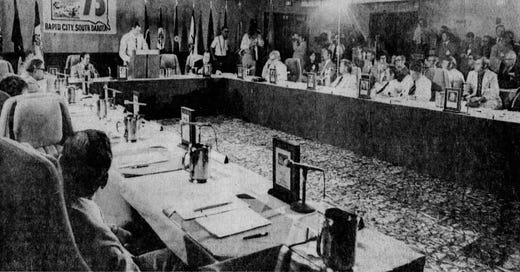SCOUTING YESTERDAY: Kneip lauds South Dakota government reorganization to Midwest governors
This week in South Dakota history: July 8-11
Governors from 14 states met at the 12th annual Midwest Governors’ Conference in Rapid City from July 9-11, 1973, according to the Rapid City Journal.
South Dakota Gov. Richard Kneip invited governors to Rapid City just weeks after the Black Hills flood, which killed 238. State officials had worried about the impact of the flood along with gasoline shortages on the state’s tourism industry and saw the conference as an opportunity to show that only select portions of the Black Hills were impacted by the flooding.
Kneip, the last Democrat to serve as governor in South Dakota, opened the conference by saying, “Never before have so many of the nation’s governors gathered in our state, and certainly no conference in the history of our state has been so destined to impact the lives of our region and the nation.”
Governors discussed a variety of issues including the ongoing fuel shortages, government reorganization and chief executive problem solving.
Concerning the nation’s fuel shortage, the governors felt that it was a true shortage of fuel and refuted the Federal Trade Commission’s theory that major oil companies were forcing prices up. Gov. Link of North Dakota had driven to the conference in an effort to save gasoline while Gov. Exon of Nebraska promoted the idea of exchanging food for fuel to deal with both international crises, according to the Argus Leader.
Kneip spoke July 10 on the subject of government reorganization. Kneip spoke of his own success reorganizing the state government from 166 state agencies, boards and commissions down to 16 major departments, according to the Argus Leader. Kneip pointed out the difficulty of dealing with government bureaucracy throughout the process.
“People in government are fighting as hard as they can to keep things exactly the way they’ve always been.”
The Argus Leader reported the governors were presented with gifts from the host committee, including moccasins, cufflinks made from Black Hills gold, fishing equipment and portraits while their wives were presented with bracelets depicting Mt. Rushmore and the state bird — the pheasant. Governors were treated to golf, tennis and a tour of the Black Hills before a formal dinner July 11.
More notable happenings from this week in South Dakota history
July 8, 1948 — The Argus-Leader reports that Minnehaha County commissioners have heard from Wynn D. Crew of Dakota Microfilm. Crew presented two proposals for microfilming the county records, which were overflowing seven vaults. The files could be stored in two file cabinets if on microfilm and the conversion process would take about one year, according to Crew.
July 9, 1923 — The Daily Deadwood Pioneer-Times reports a heavy cloudburst left Custer basements flooded and washed out 1,900 feet of the Burlington rail track between Custer and Berne. The heavy rains came between 12:30 and 1:30 and left up to 18 inches of water in the streets.
July 10, 1973 — A one-and-a-half year old is lucky to be alive in the Rapid City hospital after a mountain lion attack at Bear Country, according to the Lead Daily Call. The boy’s mother and grandfather were also injured when the mountain lion made its way into the family’s van. The boy’s grandmother was able to kill the lion, stabbing it with a knife.
July 11, 1923 — The Weekly Pioneer Times reports South Dakota has more institutions of higher learning per citizen than any other state. Arwin D. Aldrich, Commission of Immigration, says “it shows the high ideals and ambition educationally.”







